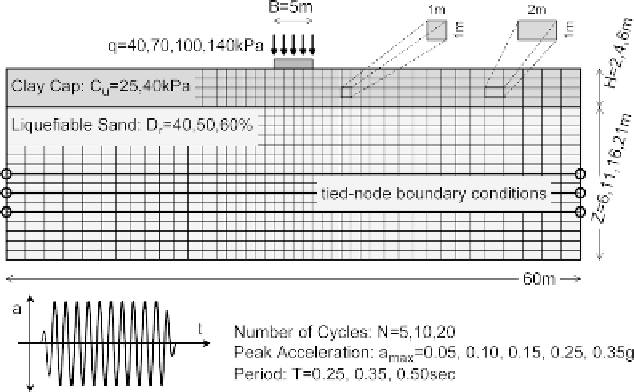Geoscience Reference
In-Depth Information
pore pressures and settlements, which are indicative of the level of accuracy that should
be expected fromthe numerical analyses.
Usingtheabovementionednumericalalgorithm,wewentonwithanumberofparametric
analyses (i.e. “numerical experiments”) of the response of strip footings resting on the
surface of a liquefiable layer, consisting of fine Nevada sand at various densities, with a
clay crust. Inall, 73 suchanalyses were performed, each one including three steps:
- initial staticloading, performed under drained conditions,
- dynamic loading due tohorizontal seismicshaking applied at the base of the model,
performed under partially drained conditions, and
- post-seismicstaticloading tofailure,performed under undrained conditions.
The basic geometry of the model, the static and seismic loads, the basic soil charac-
teristics, as well as the assumed discretization and boundary conditions are shown in
Figure11.10.Inadditiontotheinformationgiveninthisfigure,notethatthefootingwas
rigid and massless, while the average reported values of initial static loads correspond to
static factors of safety
FS
o
=
00. Furthermore, to simulate free field conditions
atthesideboundariesofthemodel,thecorrespondingoppositenodesweretiedrigidlyto
each other so that they were forced to exhibit the same horizontal displacements during
shaking.
1
.
50
−
5
.
A detailed presentation of the parametric analyses is not within the scope of this article.
Still,itisworthpresentingasetoftypicalexcessporepressureandsettlementtimehisto-
ries predicted from the parametric analyses (Figure 11.11a and b). A closer look at these
results reveals some basic internal mechanisms of foundation-soil interaction during
liquefaction, which have been alsoidentified inanumber of centrifuge experiments (e.g.
Fig. 11.10. Numerical model used forthe parametric analysis of the liquefaction
performance ofstripfoundations, and range of basic input parameters

